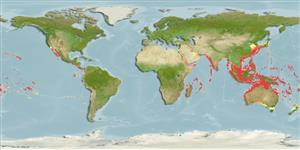Common names from other countries
Classification / Names / Names
Nomi Comuni | Sinonimi | Catalog of Fishes (gen., sp.) | ITIS | CoL | WoRMS
Environment: milieu / climate zone / depth range / distribution range
Ecologia
; distribuzione batimetrica 10 - 280 m (Ref. 349), usually 10 - 50 m (Ref. 349). Tropical
Indo-Pacific: from East Africa, including the Persian Gulf to the Society Islands; north to Japan, and south to New Caledonia, Australia and possibly New Zealand. Tropical to subtropical.
Length at first maturity / Size / Peso / Age
Maturity: Lm ? range ? - ? cm Max length : 7.0 cm SHD maschio/sesso non determinato; (Ref. 821); common length : 5.0 cm SHL maschio/sesso non determinato; (Ref. 349)
Occasional bycatch of shrimp trawlers (Ref. 349). Most common in shallow waters (Ref. 349). In general, members of the family Architectonicidae are carnivores (Ref. 67623).
Life cycle and mating behavior
Maturità | Riproduzione | Deposizione | Uova | Fecundity | Larve
Members of the order Heterostropha are mostly simultaneous hermaphrodites.
Poutiers, J.M. 1998. (Ref. 349)
IUCN Red List Status (Ref. 130435)
CITES status (Ref. 108899)
Not Evaluated
Not Evaluated
Threat to humans
Harmless
Human uses
| FishSource |
Strumenti
Informazioni ulteriori
Age/SizeAccrescimentoLength-weightLength-lengthMorfologiaLarveAbbondanza
Fonti Internet
Estimates based on models
Preferred temperature
(Ref.
115969): 23.1 - 29, mean 28 (based on 1836 cells).
Vulnerability
Low vulnerability (10 of 100).
Price category
Unknown.
